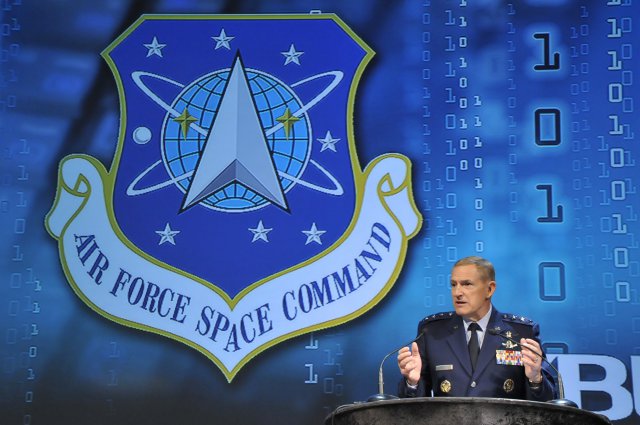 The Air Force Space Command Vice Commander discussed AF cyberspace operations during the opening session of the Space Foundation’s Cyber 1.2 conference at The Broadmoor Hotel, Colorado Springs on Monday.
The Air Force Space Command Vice Commander discussed AF cyberspace operations during the opening session of the Space Foundation’s Cyber 1.2 conference at The Broadmoor Hotel, Colorado Springs on Monday.
Lt. General Michael Basla highlighted progress made in AF cyber operations over the past year, discussed war and cyberspace, cyber operations risk and risk mitigation during his remarks that opened the conference. “Cyberspace is a part of every war fight, every mission that we’re in,” explained General Basla. “Everyone is focused on cyber.”
The General said the last year has been a busy one with measurable progress. Multiple Department of Defense and Department of the AF offensive and defensive cyber operations capabilities have been developed, tested, fielded and operationalized. Each new capability was developed and deployed with a weapons system mindset; from hardware, to software, to certification of the operators.
In addition, the Cyberspace Professional Development plan was signed Dec. 2011 and put into action. To date, more than 5,700 cyberspace professionals have been certified. “This is a deliberate development program for cyberspace professionals that makes sure they have the technical and the tactical depth and breadth required,” said General Basla.
Finally, the AF Network, or AFNET, migration has been the number one cyberspace priority for the command and has shown significant progress, General Basla said. Since last year, 167,000 users and 40 sites around the world have been successfully migrated with completion expected in 2013. In addition, 27 legacy cyber systems have been retired.
The General also highlighted the important role that cyberspace plays in war today as well as into the future. “Cyberspace is closely linked to everything we do in war,” said General Basla. “It is both a warfighting domain…and an enabling capability.”
From GPS-enabled Joint Direct Attack Munitions to the cyberspace command and control links and satellite superiority vital to the Remotely Piloted Aircraft mission, space and cyberspace are vital to the warfighter, the General said. The cyber domain also comes with risk, risk that must be and is being mitigated, said General Basla.
“We have to assume that the enemy will be inside our networks for malice, curiosity, or just for the challenge,” explained the general. “We must prioritize our defense efforts with a mission assurance approach.” The General further explained that it only takes a cheap laptop and an internet connection for an adversary to become a major player and threat in the cyberspace domain.
Twenty-fourth AF has created “Hunter Teams,” cyberspace defenders who actively search for enemies on AF networks with the purpose of identifying, pursuing and mitigating cyberspace threats, providing the AF with an element of deterrence.
These cyberspace defenders recently participated in RED FLAG 12-3, honing their cyber skills by defending the C2 mission of the Combined Air Operations Center at Nellis Air Force Base, NV. It was the first time “Hunter Teams” took part in the AF’s advanced aerial combat training exercise.
The General closed by emphasizing the need for all Airmen to be better consumers of cyberspace. “Our Airmen are very, very conscious of FOD on a runway. But are they as conscious about those downloads? Are they as conscious about that thumb drive that they plugged into their desktop?”
Source: Air Force Space Command
